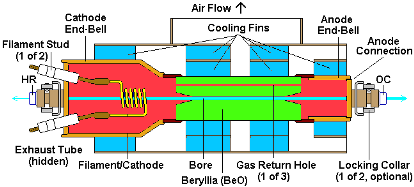Argon LASER (An Ion Gas Laser)
Argon is the name of gas. The argon laser active medium consists of this gas, where the lasing takes place due to ions of argon gas. That is why argon laser is the most popular type of ion lasers.
Remember that to form ions from argon atom, electrons are removed from argon atom by applying proper high energy or voltage.
Characteristics of Argon laser
All ion lasers (such as argon, Krypton and mix gas) produce several different wavelengths so they are designed to produce these wavelengths either simultaneously or individually.
The argon laser produce nine different wavelengths in which two are most powerful and most commonly used. These are in the blue and blue-green spectral regions, which are at 488nm and 514nm respectively. Argon lasers are generally operated in continuous wave mode although it is possible to mode lock them to get very rapid, short duration pulses.
For argon lasers the output power can ranges from few mill watts up to 20 watts.
The argon lasers have a long narrow laser cavity, which produces relatively high power TEM0,0 beam output with very low divergence typically about 1 milli radian.
The overall efficiency of the argon laser varies from about 0.01% to 0.1%, with average efficiency about 0.02% with efficiency in these ranges, it is necessary to apply large amount of power to the laser, in order to get an output. For example if a laser has an efficiency of 0.1% then it is necessary to apply 1000 watts of power to laser in order to achieve an output of 1 watt. Remember that in these like cases the remainder of the input power is dissipated as heat.
Construction of Argon lasers
The argon lasers are constructed differently from the He-Ne laser. Because argon lasers have efficiency very low, so needs large amount of power as input, which produces the tremendous amount of heat. A typical argon laser can be shown as:

The figure shows that in argon laser there are cooling fins on the outside of the tube. This is one method of dissipating the heat generated during the lasing process. Some time instead of cooling fins, the water jacket surrounds the tube where water is forced through the jacket to cool the tube. This water jacket method is most common in high power argon lasers.
Since the argon laser use arc discharge method to produce lasing where very high levels of excitation energy is needed. This high level of excitation produces extremely high currents through the bore or capillary tube. So the current density through the ore tube reaches several hundreds amperes per centimeter. It is that current which produces excessive heat. Now to resist this heat, the bore tube must be constructed from such material like beryllium oxide, graphite or tungsten. Usually the bore diameter is about 0.1125 centimeter.
The ionized gas in the bore tube contains many charged particles which force themselves away from each other towards the edges of the tube where they become cooled and thus lose the necessary energy for excitation. To solve this problem the magnetic coil or solenoid is placed around the tube and a magnetic field applied to the ionized gas. The magnetic field forces the ions back into the center of the tube where their energy can be retained.
The mirrors in argon laser are not directly connected to the laser tube because high temperature are associated with argon. Instead of direct connected mirrors, the Brewster windows are utilized at either end of the tube between Brewster window and HR mirror. There is inserted a device called prism.
In argon laser the power supply is also used which must be able to supply large amounts of current needed for lasing process and also provide enough voltage for the solenoids operation. The power supply is connected to anode and cathode of the tube.
Function of Argon laser
We know that the active medium in an argon laser is a pure argon gas. The gas can reach to the excited state (necessary for lasing ) through either direct excitation of argon atom or through further excitation of the already excited argon ion. In either process more of the argon atoms follow the two steps process that is atom-to-ion & ion-to-further-excited-ion. These two state processes has two results, 1st one is “intense or extremely high current discharge” and 2nd one is “the production of several wavelengths of energy”.
Simplified energy level diagram for an argon laser can be shown as:

This diagram shows that a number of different wavelengths are produced by lasing argon gas. In all these wavelengths only two 488nm (blue spectral region) and 514nm (blue-green spectral region) are very important and predominant. All other wavelengths produced have considerably less power than either of these two.
Note That! As with all lasers, the argon laser also uses a pair of mirrors as feedback mechanism. However since argon laser is a higher gain system there for e the percentage of reflectivity for the mirrors is less critical.
Applications of Argon Laser
- Argon lasers used in scientific research.
- Argon lasers used in medical application.
- An artistic displays and light shows also the argon lasers are used.
Advantages of Argon Laser
- Production of multiple wave lengths is the main advantage plus characteristic of argon as well as other ion lasers.
- Argon lasers produce high power output as compared to He-Ne laser.
- Argon laser is a higher gain system.
- Argon laser like He-Ne has very less divergence, typically about 1 milli radian.
Disadvantages of Argon laser
- The overall efficiency of argon laser is very less usually lies between 0.01% and 0.1%.
- Large amount of power requirement is also its disadvantage.
- Construction is very difficult.
- Cost of argon laser is not as low as He-Ne laser.
- Power supply of high voltages required, because due to solenoid there is extra burden on it.
